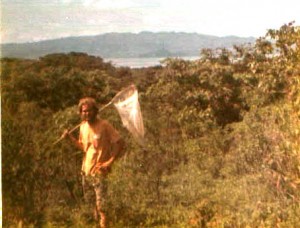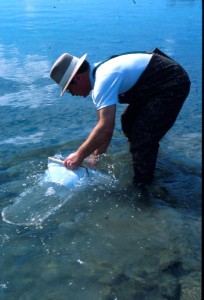Nets.Second only to jars, nets of various designs and construction materials are available and suitable for capturing mobile and aquatic insects. Using the right type of net will enhance any collector’s abilities.
Aerial nets.Also called butterfly nets, this is the tool most associated with insect collecting, especially for collecting butterflies. These nets are generally made of light weight materials that include a wooden or aluminum handle and a hoop constructed of stiff steel “music wire” or steel strap. The net is made from fine mesh material usually reinforced with cotton around the hoop. Various diameter hoops are available with 12 to 18 inches diameters being more common. The hoop is affixed to the handle in various ways depending on construction materials used. Length of poles vary from a standard length of about 3 to 5 feet. Longer and telescoping poles are also commercially available.
Making your own net is possible (See “How to Make a Butterfly Net”) , but the challenge is finding materials from which to construct the hoop. Coat hanger wire is not suitable and “music wire” sold at hobby stores are generally not long enough to create a hoop of suitable diameter.
Technique tips: Many insects, particularly butterflies, true bugs and flies seek light when distressed or panicked. When you “bag” an insects, hold the tip of the bag and point it towards the sunlight. The insects will climb towards the light and not escape from the bag when you reach in to retrieve the specimen either by hand or with a jar.
Sweep nets. Although similar to aerial nets, sweep nets are made of heavier-weight and sturdier materials and are better suited for collecting plant-infesting insects like true bugs, beetles and other chewing and sucking insects of medium-small to large sizes. Bags are made entirely or partially from heavier cotton cloth. They are designed to be swung through plant foliage is a systematic sweeping motion while walking forward at a steady pace. After a set number of “sweeps” contents can be carefully be removed and specimens collected in a container or the entire contents can be placed in a such as a paper or plastic bag for sorting later such as after freezing.
Sweep nets are used in sampling programs because collections of specific numbers of sweeps (i.e., 100 sweeps) can constitute a “sample unit” of insect populations. Results of repeated sampling over space or time can provide information about relative population levels, information useful for those managing pest populations in agricultural crops like rice and soybeans.
Aquatic nets. Nets for collecting insects in water come in a variety of styles. Fish nets sold at pet stores or aerial nets are suitable for collecting species that swim in or on the surface of water (e.g., water striders, water boatman, mosquito larvae). More durable nets with canvas bags or hoops with square or triangular shapes are more suitable for collecting bottom-dwelling species (e.g., may fly larvae, hellgrammites, bloodworms) and are usually held down stream while disturbing soil and rocks on the bottom of flowing water so specimens float into the net.



